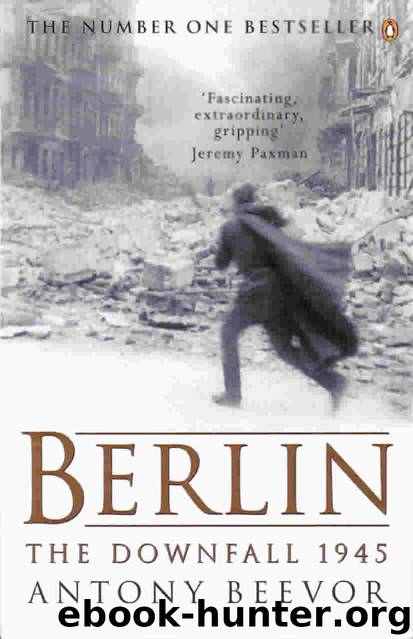Berlin. The Downfall 1945 by Antony Beevor

Author:Antony Beevor [Beevor, Antony]
Language: eng
Format: epub, mobi
Tags: World War II, Non fiction
Publisher: Penguin Publishing
Published: 2008-11-18T23:00:00+00:00
16
Seelow and the Spree
After Stalin’s two midnight telephone conversations on 16 April, the race between Zhukov and Konev began in earnest. Konev, incited by Stalin, rose enthusiastically to the challenge. Zhukov, although rattled by the setback on the Seelow Heights, believed that Berlin was his by right.
The overcast sky and drizzle gave way to better weather on Tuesday 17 April. The Shturmoviks were able to attack the remaining German positions on the Seelow Heights with much greater accuracy. Down on the Oderbruch and up on the escarpment, small towns, hamlets and individual farmhouses still burned. The Soviet artillery and aviation had targeted any building in case it housed a command post. This resulted in an overpowering smell of charred flesh, mostly human in the villages and livestock on the farms. The shelling of farm buildings as likely depots and headquarters led to a terrible slaughter of animals unable to escape from being burned alive.
Behind the indistinct German lines, dressing stations were filled with wounded far beyond the capacity of the doctors. A stomach wound was as good as a death sentence under the system of triage, since the surgery it required took too long. The first priority for treatment were those capable of further combat. Specially detailed officers trawled the field hospitals for walking wounded capable of firing a gun.
The Feldgendarmerie at their improvised roadblocks were always on the lookout for stragglers, whether fit or lightly wounded, who could be forced back into scratch companies. As soon as a reasonable number had been assembled, they were marched into the line. Soldiers called the Feldgendarmerie not only ‘chain-hounds’, but also ‘Heldenklauen’, or ‘hero-stealers’, a play on the Nazi term ‘Kohlenklau’ used to attack those who stole government coal for use at home.
In their brutal zeal, the Feldgendarmerie often grabbed men who were genuinely trying to rejoin their battalions. They then found themselves mixed in with stragglers and fifteen- or sixteen-year-old Hitler Youth, some of whom were still in shorts. A smaller size of steel helmet had been manufactured for boy soldiers, but not nearly enough were produced. Their tense, pale faces could barely be seen under helmets that dropped over their ears. A group of Soviet sappers from the 3rd Shock Army called forward to clear a minefield were taken by surprise when a dozen Germans emerged from a trench to surrender. Suddenly a boy appeared from a bunker. ‘He was wearing a long trench-coat and a cap,’ recorded Captain Sulkhanishvili. ‘He fired a burst with his sub-machine gun. But then, seeing that I didn’t fall over, he dropped his sub-machine gun and started to sob. He tried to shout, “Hitler kaputt, Stalin gut!” I laughed. I hit him only once in the face. Poor boys, I felt sorry for them.’
The most dangerous of the Hitler Youth were often those whose homes and families had been ripped apart in the east by the Red Army. The only course for them seemed to be death in battle, taking as many hated Bolsheviks with them as possible.
Download
This site does not store any files on its server. We only index and link to content provided by other sites. Please contact the content providers to delete copyright contents if any and email us, we'll remove relevant links or contents immediately.
| Africa | Americas |
| Arctic & Antarctica | Asia |
| Australia & Oceania | Europe |
| Middle East | Russia |
| United States | World |
| Ancient Civilizations | Military |
| Historical Study & Educational Resources |
The Radium Girls by Kate Moore(11886)
100 Deadly Skills by Clint Emerson(4816)
Rise and Kill First by Ronen Bergman(4669)
The Templars by Dan Jones(4610)
The Doomsday Machine by Daniel Ellsberg(4386)
The Rape of Nanking by Iris Chang(4116)
Killing England by Bill O'Reilly(3936)
Hitler in Los Angeles by Steven J. Ross(3879)
Stalin by Stephen Kotkin(3842)
12 Strong by Doug Stanton(3470)
Hitler's Monsters by Eric Kurlander(3251)
Blood and Sand by Alex Von Tunzelmann(3112)
Darkest Hour by Anthony McCarten(3052)
The Code Book by Simon Singh(3044)
The Art of War Visualized by Jessica Hagy(2908)
Hitler's Flying Saucers: A Guide to German Flying Discs of the Second World War by Stevens Henry(2680)
Babylon's Ark by Lawrence Anthony(2515)
The Second World Wars by Victor Davis Hanson(2461)
Tobruk by Peter Fitzsimons(2425)
